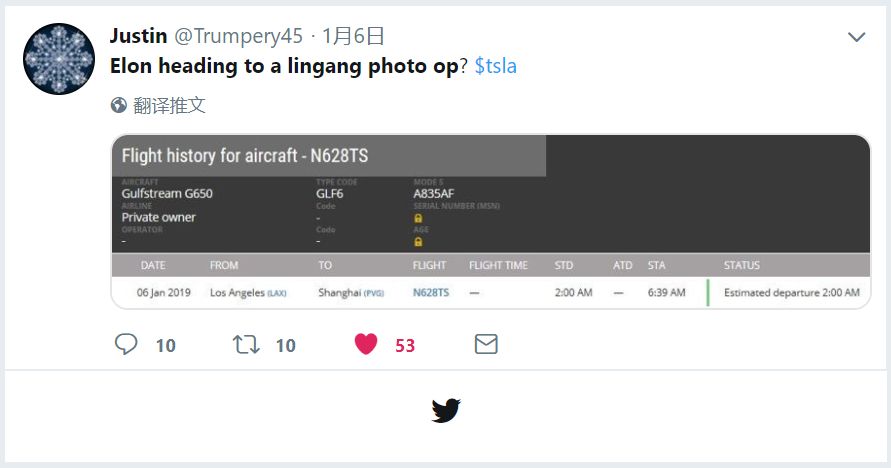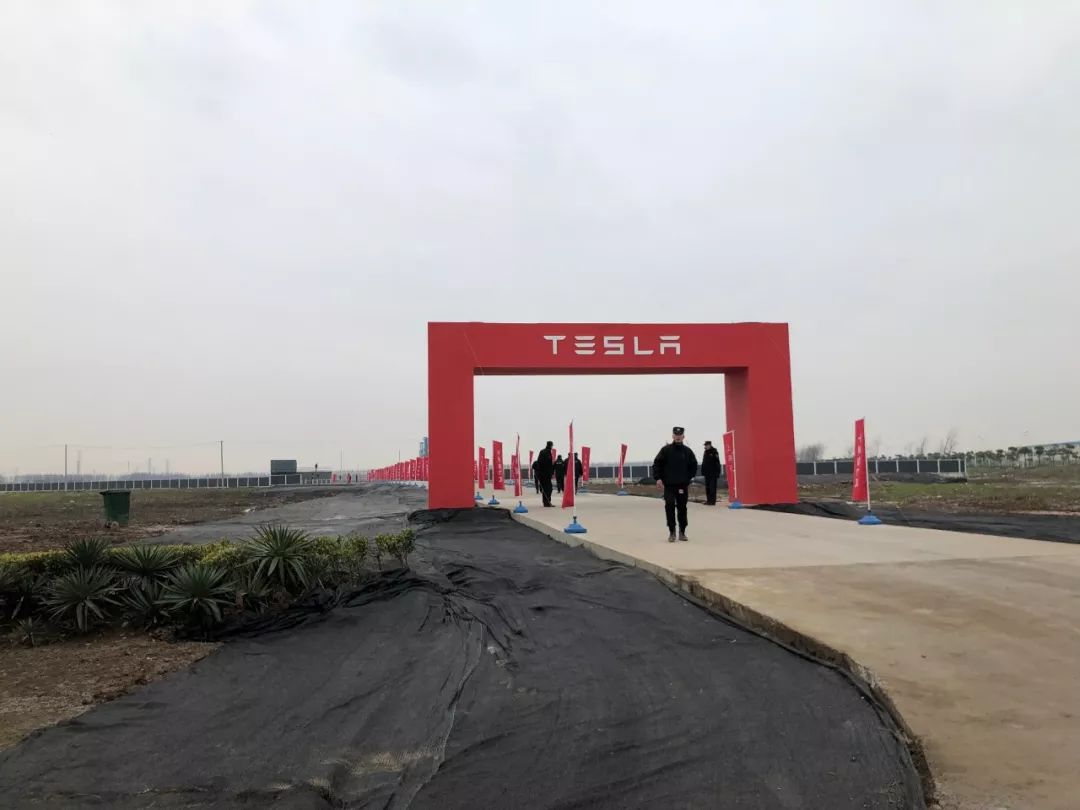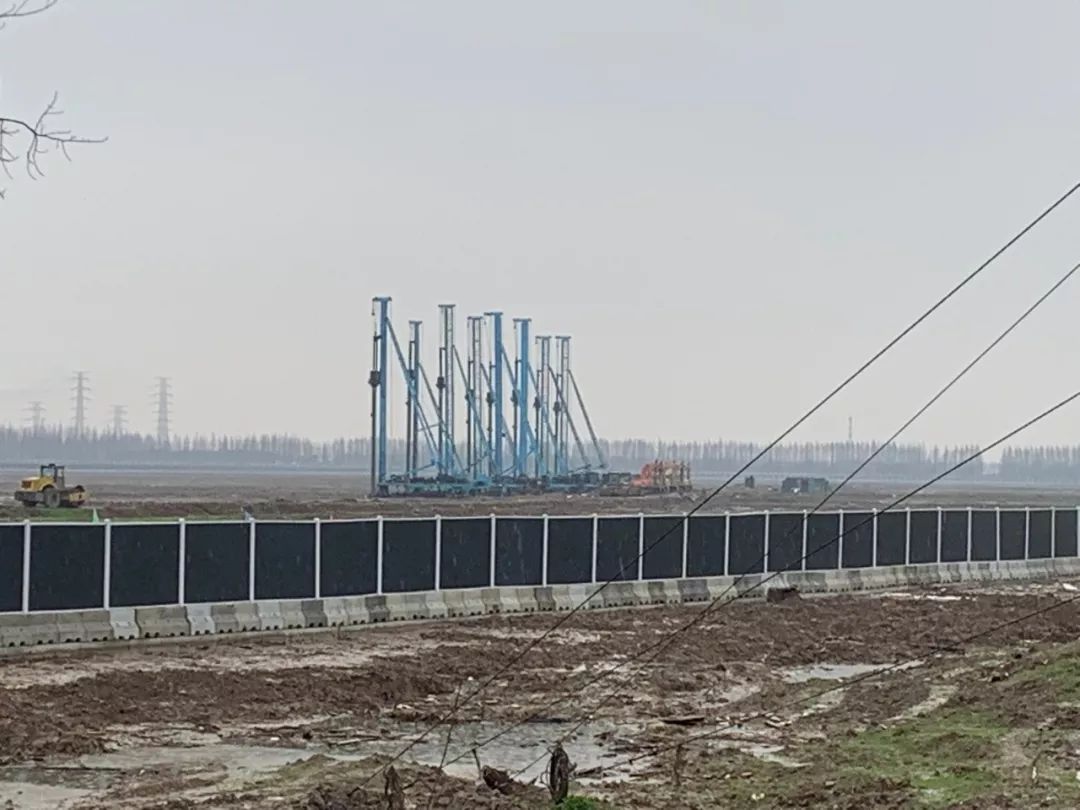Groundbreaking
On January 7, 2019, while many Chinese automotive media were flying to Las Vegas to attend the CES exhibition, Tesla CEO Elon Musk flew to Shanghai on his private jet for one thing only: the groundbreaking ceremony of the Tesla Shanghai factory.
Yesterday, a Twitter user named Justin shared a flight itinerary screenshot, showing that Elon’s private jet Gulfstream G650 would fly from Los Angeles to Shanghai on the same day.

There is only one possibility for him to come to Shanghai at this time: there will be new developments at the Shanghai factory. So we decided to drive there.
At 10:36am, Elon, who had just arrived in Shanghai, announced officially: “Looking forward to breaking ground on Tesla Shanghai Gigafactory.”

Meanwhile, we arrived at the Tesla Gigafactory in Shanghai. At the entrance was a square arch with Tesla written on it, and banners on both sides with Tesla and Shanghai Lingang respectively.

From the factory’s surroundings, we could see that the Tesla factory is still undergoing land leveling work. A few excavators, road rollers, and large-scale pile driving machines were lined up inside the factory.

Continuing on, workers were busy signing in at the sign-in desk nearby.
At 3:28pm, Tesla CEO Elon Musk, Tesla global vice president of sales and service Robin Ren, Tesla Asia Pacific president and Shanghai Gigafactory head Zhu Xiaotong, Tesla general counsel Todd A. Maron, and other management representatives appeared at the groundbreaking ceremony.
 # Tesla Shanghai Gigafactory
# Tesla Shanghai Gigafactory
During the groundbreaking ceremony, Chinese officials including Vice Secretary and Mayor of Shanghai, Ying Yong, Deputy Mayor of Shanghai, Wu Qing, officials from Shanghai Municipal Government, Ministry of Industry and Information Technology and National Development and Reform Commission were present with great importance attached to the ceremony. After a brief speech by Elon Musk, the two sides jointly held the groundbreaking ceremony.
In his speech, Elon mentioned that China has become a world leader in the application of electric vehicles, with Tesla’s mission to “accelerate the world’s transition to sustainable energy”, the Chinese market is very important for us to achieve this vision. This sentence “China has become a world leader in the application of electric vehicles” can be further discussed and interpreted.
During the groundbreaking ceremony, Elon announced the positioning of the Gigafactory in Shanghai through Twitter:
-
Tesla will complete the initial construction of the factory this summer, and will start production of the Model 3 by the end of the year, with a large-scale production to be achieved by 2020.
-
The Model 3 and Model Y produced in the Shanghai factory will cover the Tesla Greater China area.
-
Only the entry-level models will be produced in the Chinese factory. The entire Model S and Model X series, as well as the flagship version of the Model 3 and Model Y, will be produced in the United States and exported globally (including China).
Considering that Tesla has already opened Chinese reservations for its flagship and mid-range Model 3, local production will have a considerable downward pressure on the pricing level. To avoid pricing confusion, Tesla’s strategy is not surprising.
Finally, some good news for Chinese Model 3 reservation holders, according to Elon’s statement, Tesla will complete the delivery of the first batch of Model 3 within several weeks. Even if it takes 9 weeks, Chinese consumers can still pick up their car before March.
After the Lunar New Year, get ready to pick up your car.
“China was really some next level stuff.”
It’s time to review the Tesla Shanghai Gigafactory.
On August 1, 2018, during Tesla’s Q3 earnings call, Elon revealed the latest progress on Tesla’s Shanghai factory. A day later, the Tesla recruitment account posted a job posting entitled “The Dreadnought Is About To Sail”.
In that article, Tesla officially defined the Shanghai Gigafactory as a “dreadnought factory” that combines R&D, manufacturing and production of batteries and vehicles.During the previous day’s earnings conference, Elon gave more details about the Shanghai factory. The Shanghai Super Factory is designed with a production capacity of 500,000 vehicles per year and a design investment of $2 billion, both of which exceed the scale of any new Chinese automaker. In terms of specific implementation, the Shanghai Super Factory will construct four major automotive process production lines, power battery module, and pack production lines. It is worth noting that Elon has specifically mentioned that compared to Gigafactory 1, the level of automation in the Shanghai Super Factory will improve by an order of magnitude.
Tesla CTO J.B. Straubel stated that Tesla regards the Super Factory as its largest product, so all knowledge and experience learned during the product development of Gigafactory 1 will be shared with the Shanghai factory construction team to achieve the goal of building a factory with equivalent production capacity with less than half the investment.
The name “Dreadnought” is also derived from Elon’s naming of Tesla’s next-generation fully automated factory. In the past two years, Elon has frequently mentioned his thinking on the landing of Tesla’s next-generation factory automation.
The automation of the factory and products complement each other. We clearly see that from Model 3 to Model Y, Tesla has been making efforts to increase product intelligence while reducing product manufacturing complexity to facilitate the landing of fully automated factories.
Therefore, the Shanghai factory will become the most advanced and highly automated factory in Tesla’s worldwide production network, surpassing Gigafactory 1.
Finally, let’s talk about the significance of the domestically produced Model 3 and Model Y. During Elon’s speech, he mentioned that “China has become a leader in global electric vehicle applications.” To be frank, even if China is not a leader, it is still a strong competitor in the global electric vehicle industry. Below is a comparison of same-class pure electric SUVs scheduled for release before 2020. You will find that in the 1v1 comparison, products manufactured by Chinese automakers are not behind top luxury brands in the world.
Tesla’s Shanghai factory is clearly due to the consideration of winning competition through pure product strength by eliminating unfair factors such as tariffs.
Who will benefit from the domestically produced Model 3 and Model Y?Mercedes-Benz C-Class, BMW 3 Series, and Audi A4, or Mercedes-Benz E-Class, BMW 5 Series, and Audi A6, which market faces greater pressure?
It should be noted that, as a B-class car, the Model 3 had an average price of no less than 58,000 USD throughout 2018. This can be viewed from two perspectives: either Tesla has achieved a higher brand premium than BBA, or the Model 3 has the product strength to compete beyond its class.
From either perspective, both Model 3 and Model Y capture the most critical and important product lines and markets of BBA.
Some believe it is difficult for Tesla to put pressure on BBA in China.
A year ago, they did not believe that the Model 3 could take more than half of the new car market share for midsize luxury cars in the United States with an average price far beyond competitors, a market without any competition, and sales that depended purely on production capacity.
Neither believing in electric nor in smart, they watched the new species disrupt the market through disruptive innovation. We have seen too many industrial reforms like this.
Now, it’s your turn, BBA. Are you ready?

This article is a translation by ChatGPT of a Chinese report from 42HOW. If you have any questions about it, please email bd@42how.com.
